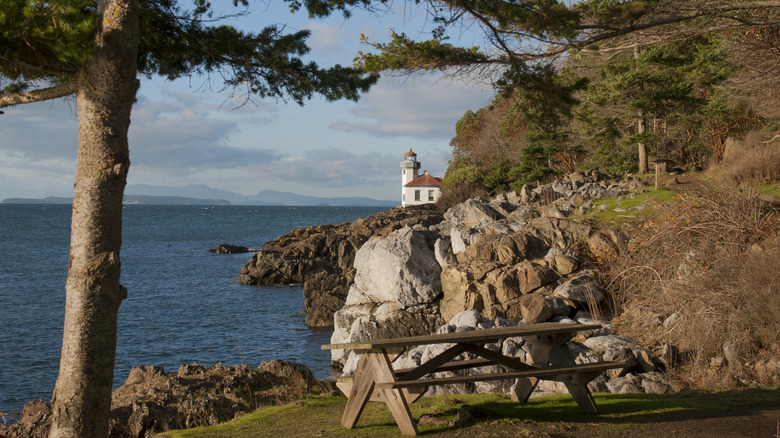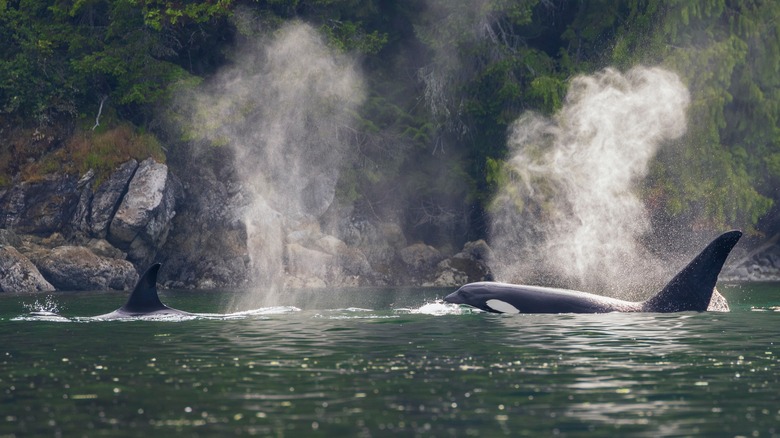Washington's State Park On The Edge Of An Island Has World-Class Whale-Watching And Views That Stretch To Canada
The San Juan Islands are considered one of the best destinations for whale watching in the world. And this is especially true on the main San Juan Island, specifically at Lime Kiln State Park. A gorgeous spot on an already picturesque island, Lime Kiln is nicknamed "Whale Watch Park," as it's one of the best places on Earth to spot whales from land. Overlooking the Haro Strait, which forms part of the border between the United States and Canada, orcas are commonly seen from various overlooks at the park, as they hunt, forage, and play.
To reach the island, the best way is via Anacortes, 1.5 hours north of Seattle-Tacoma International Airport. Regular ferries depart here for Friday Harbor, San Juan Island's biggest town, which is a charming, coastal retreat. Book ahead on the Washington State Department of Transportation (WSDOT), as they fill up quickly in the season! The trip from Anacortes to Friday Harbor takes, on average, one hour; it's truly one of the most beautiful ferry crossings in the world. (If you're lucky, you may spot whales on your trip over.) Once you reach Friday Harbor, it's a 15-minute drive to Lime Kiln, on the opposite side of the island.
Parking is free with a Washington State Discover Pass, which can be purchased at the entrance to Lime Kiln. (Good for a full year, throughout the state). Once you park, views of the ocean are a short 300-yard walk through the unique madrona forest. The madrona is native to this specific area of the Pacific Northwest; you'll recognize it by the distinctive red bark. Once you reach the coast, the historic 1919 lighthouse, which features a whale listening station, can be seen once you exit the forest. Back at the parking area, there's an interpretive center and gift shop, along with a food truck.
Whales, trails, and views to Canada
Lime Kiln Point is the ideal place for spotting orcas, both transient and resident. More commonly seen, transient orcas eat primarily seals and porpoises. The Southern Resident orcas, who subsist only on Chinook salmon, are traditionally from the Salish Sea. They're split into three family groups (J, K, and L) and only breed with each other, creating a unique ecotype. Sadly, the Southern Residents are extremely endangered, and these days, it's more likely to see a transient than a resident, due to the availability of salmon (and a whole host of other factors).
In addition to orcas, many other marine animals can be seen in the Haro Strait, including gray whales, minke whales, porpoises, seals, sea lions, and otters. Look up to glimpse sea birds or even a bald eagle, if you're lucky. Bring your binoculars and a hefty dose of patience, as even Whale Watch Park doesn't guarantee a whale sighting.
Along the coast path, on a sunny day, you can see clear to Canada — specifically, Vancouver Island of British Columbia. Various trails in the park also lead to the old lime kiln (the park's namesake). Upland Trail is longer and less-traveled than the main trail from the parking lot, but it will eventually take you to both the lime kiln and the lighthouse, then back to the interpretive center. Keep your eyes out for whales as you walk along the shoreline, because you never know! Bring a picnic and enjoy the views while you eat from one of the picnic tables along the coastal path, and climb down to one of the small beaches for tidepools. Want to explore more of the San Juans? Consider the most secluded one, a truly stunning, tourist-free state marine park.

